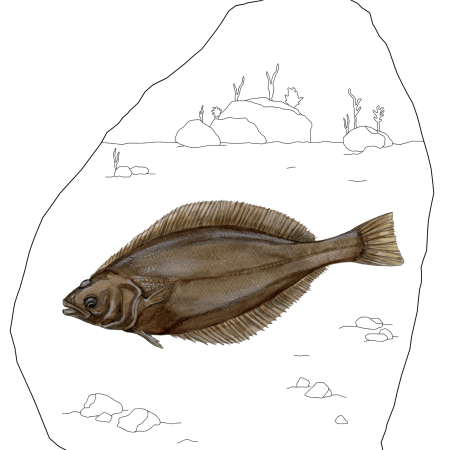
THE GREENLAND HALIBUT

- Greenland halibut stay in the Icefjord their entire lives
- The polar cod has adapted to extremely cold water
- The Greenland shark – the second largest predatory shark in the world
You solve the tasks by using
- Text
- Audio
- Drawing tools
- Pictures
This part is based on pp. 30-37 – there you will find information about the subject.
Read about the Greenland halibut, the polar cod and the Greenland shark.
The Greenland halibut is a right-eyed flatfish differing from other flatfish by having its left eye placed on the side of the body and not close to the right eye.
The Greenland halibut can weigh up to 45-50 kg and is a good and popular edible fish.

Greenland halibut in the Icefjord are on average fatter than halibut in the Disko Bay.
How do you tell a Greenland halibut from other flatfish?
Flatfish often live at the bottom where they can hide – does that go for the Greenland halibut too?
Why are Greenland halibut in the Icefjord fatter than other Greenland halibut?
The polar cod can be distinguished from other cod by the large distance between the two anal fins and the three dorsal fins.
It lives everywhere along the Greenlandic coasts. And in practically the entire arctic area.

The polar cod has “antifreeze” in its blood making it capable of living in the extreme cold, It can grow up to 35 cm.
The polar cod is not important to the fishing industry in Greenland but it serves as food for seals and whales.
Describe the polar cod. Use as many technical terms as possible.
What would happen to the cod if it did not have antifreeze in its blood?
What does the polar cod eat?
The Greenland shark is a great mystery as it lives in very deep water and thus is difficult to watch.
Exactly how old it can grow is not known but at least 250 years.

The Greenland shark is practically blind due to a parasitical copepod sitting in its eyes.
It moves very slowly and is called sleeper shark. Nevertheless it feeds on seal and cod.
How can the Greenland shark catch seals swimming much faster than itself?
The Greenland shark’s visual sense is practically non-existent, but its electrical sense works really well. What senses do humans have?
The shark has a parasitical copepod in its eyes – what does parasitical mean?
The Greenland halibut is a right-eyed flatfish differing from other flatfish by having its left eye placed on the side of the body and not close to the right eye.
The Greenland halibut can weigh up to 45-50 kg and is a good and popular edible fish.

Greenland halibut in the Icefjord are on average fatter than halibut in the Disko Bay.
How do you tell a Greenland halibut from other flatfish?
Flatfish often live at the bottom where they can hide – does that go for the Greenland halibut too?
Why are Greenland halibut in the Icefjord fatter than other Greenland halibut?
The polar cod can be distinguished from other cod by the large distance between the two anal fins and the three dorsal fins.
It lives everywhere along the Greenlandic coasts. And in practically the entire arctic area.

The polar cod has “antifreeze” in its blood making it capable of living in the extreme cold, It can grow up to 35 cm.
The polar cod is not important to the fishing industry in Greenland but it serves as food for seals and whales.
Describe the polar cod. Use as many technical terms as possible.
What would happen to the cod if it did not have antifreeze in its blood?
What does the polar cod eat?
The Greenland shark is a great mystery as it lives in very deep water and thus is difficult to watch.
Exactly how old it can grow is not known but at least 250 years.

The Greenland shark is practically blind due to a parasitical copepod sitting in its eyes.
It moves very slowly and is called sleeper shark. Nevertheless it feeds on seal and cod.
How can the Greenland shark catch seals swimming much faster than itself?
The Greenland shark’s visual sense is practically non-existent, but its electrical sense works really well. What senses do humans have?
The shark has a parasitical copepod in its eyes – what does parasitical mean?



